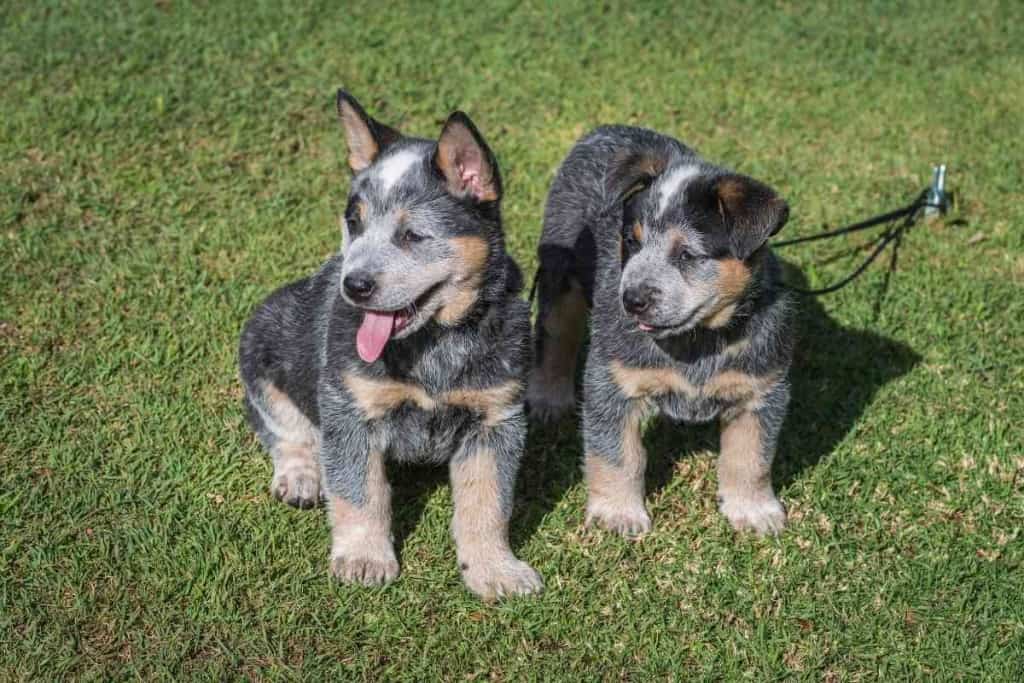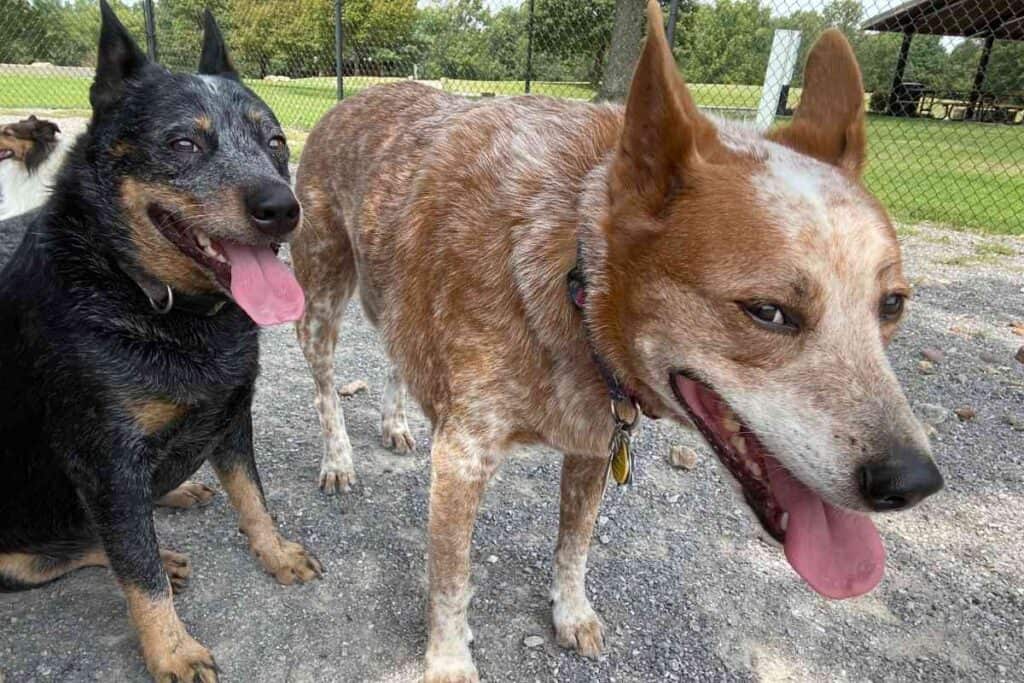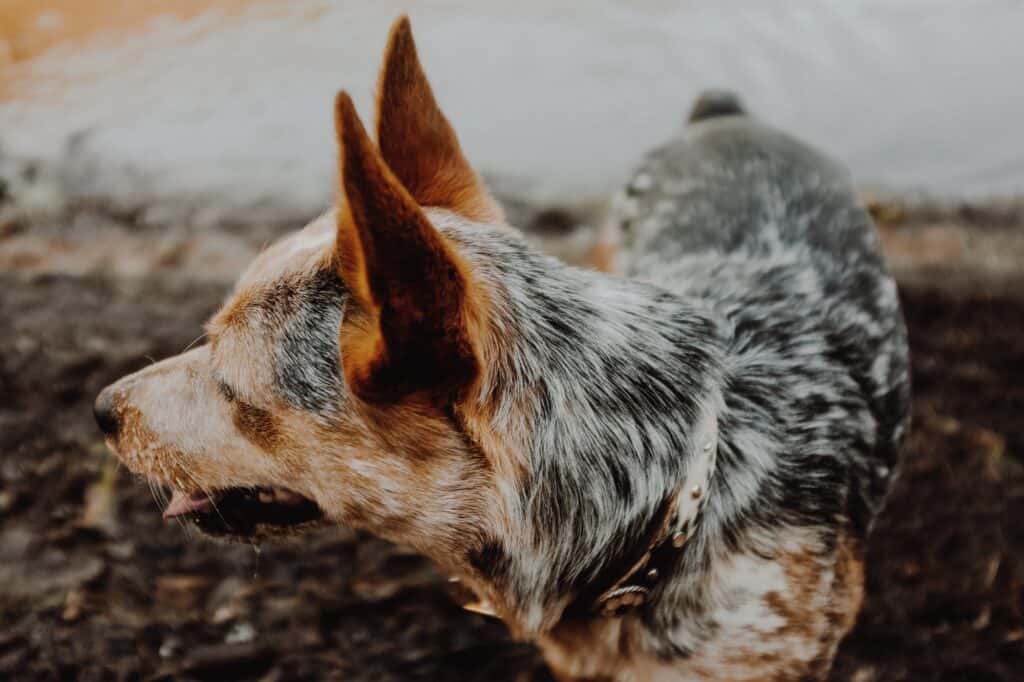Blue Heeler Size | How Big Do They Get When Full Grown?

How big do Blue Heeler dogs get? That’s the primary point of this article so lets dive into the details and figure out how big Blue Heeler puppies will get when full-grown.
How big do Blue Heelers get?
Blue Heelers can get as big as fifty pounds in weight, but they can also be as small as thirty pounds. When it comes to the height of the Blue Heeler, they can grow to an average of seventeen to twenty inches at the withers.
This will depend primarily on whether they are male or female, as females of all dog breeds are slightly smaller than their male counterparts.
Blue Heeler owners and parents need to realize that these numbers are just a guideline as some dogs will be slightly bigger or smaller in weight or height depending on their breeding, the size of their furry parents, and other issues like health and lifestyle.
The guideline is usually offered to give insight into their potential and where this or any other breed should be regarding weight and height, but it is generally based upon show dogs of each breed.
Blue Heeler dogs that do not show quality will, of course, vary and be different based on the above-listed factors.
Blue Heelers are considered a medium-size dog breed based on their size in relationship to other dog breeds.
Blue Heelers might be a medium-sized dog, but they have a solid and sturdy build that lends them well to their breed occupation of being a herding dog in Australia that can go long distances and diverse terrain to drive the cattle to where they need to go.
This breed may not be the biggest dog breed in the bunch, but they pack quite a punch for their size in terms of work, strength, and abilities.
Intelligent and capable, this dog breed is big in many ways that are not necessarily directly related to their height and weight physical attributes.
The Blue Heeler, also known as the Australian Cattle Dog, is a descendent of the Dingo. In Australia, they were bred to herd cattle over long stretches of land that had diverse terrain to get the cattle where they needed to go.
That being said, this type of occupation for a dog might require them to be of a specific size. The Blue Heeler is a dog that can weigh anywhere from thirty to fifty pounds. Factors like gender, age, lifestyle, and diet affecting this number.
When it comes to their height, they can be on average seventeen to twenty inches in height to the withers, which is the top of the shoulder.
This again will vary based on gender, genetics and the size of their furry parents, and other factors.
These numbers are primarily based on show quality dogs of this breed to set the standard, but dogs that do not show quality can vary up or down in height and weight.
Whatever the case, the Blue Heeler is a solid and capable dog despite its medium size in height and weight. Their strength, sturdiness, intelligence, and durability are what make them so good at what they do, herd cattle.
They may not be the biggest dog in the bunch, but when their many favorable qualities combine, including their medium size height and weight, they make one dependable, hard-working dog breed.

How can I keep my Blue Heeler puppy healthy as they grow, so they are as big as possible?
The best way to keep your Blue Heeler puppy healthy as they grow, so they are as big as possible, is to feed them a nutritious, adequate diet designed to enhance their overall health.
This nutrition plan should be formulated with their veterinarian or at the very least shared with their veterinarian to help ensure that they are getting ample daily nutrition.
Their veterinarian will know this breed and its abilities, strengths, and weaknesses. In some cases, they might even know the individual dogs’ furry parents, who make it easier to tailor a specific nutrition plan to the dog.
Their breeder can offer insight into who their furry parents are, which can help create a healthy nutrition plan that can carry the Blue Heeler puppy through their young years and well into adulthood and beyond.
The basics of nutrition for a puppy or dog would require that they receive food throughout the day, which can come in the form of wet or dry, or both, and a few well-placed but minimal amounts of treats.
These treats can be healthy human snacks if the puppy enjoys them, sharing them to enhance bonding between pet parents and puppy.
Such threats can include pup pops made of pumpkin and peanut butter or small morsels of fresh carrot or green beans.
Experimentation is crucial as not all puppies or dogs like the same thing. Morsels should always be bite-size for small puppies to ensure that they don’t choke.
The dog food that the puppy eats should have a small nutrients list, and the first ingredient should be protein. There should not be any additives or preservatives as these things are empty calories.
They provide no nutrition for the growing Blue Heeler puppy.
On days where the puppy is active, they may require more nutrition, and on days where they lack exercise, the number of treats they receive can be limited unless their behavior warrants them.
Ensuring that the puppy’s lifestyle is healthy with minimal stress, ample sleep, exercise, and lots of love will go a long way to keeping them healthy and happy, enhancing their growth.
While none of this will help them grow to be a bigger dog than another, it will help the Blue Heeler puppy grow healthy and robust, which is all a pet parent should be focusing on anyway.
Good health is far more critical than size either way. Some dogs may naturally be a little smaller than others in their same breed class.
This site doesn’t mean that they won’t be just as strong, if not stronger, than the bigger dogs.
Another factor that is important in a Blue Heeler puppy’s health and wellness is veterinary visits. Puppies should attend all their veterinary visits and receive vaccines and any medications they may need at any time.

At what age does the Blue Heeler puppy finish growing?
The Blue Heeler will finish growing at different phases of their puppy and adult life. They will usually finish their growth in height at anywhere from nine to twelve months.
When it comes to weight, they will usually continue to fill out and complete this growth anywhere from a year and a half to two years of age. Age and time will have their weight fluctuating throughout their lives.
How big in weight will be my Blue Heeler puppy be at the different stages of its growth?
The Blue Heeler puppy, like other dogs, will grow at their own individual pace when they pass through each different stage. Each dog is individual, and it is essential to remember the numbers listed highlight the size of most dogs in that breed.
That being said, when the Blue Heeler puppy will be about twelve to fifteen pounds at about three months of age. By the time they are four months of age, they will be sixteen to eighteen pounds.
When they reach five months of age, they will be nineteen to twenty-four pounds.
When they reach the milestone of being six months old, they will be between twenty-three to twenty-six pounds.
In the second part of the first year at seven months, the puppy can be between twenty-six and twenty-nine pounds. Eight months will bring them to twenty-seven to thirty pounds.
Finally, nine months they can be twenty-eight to thirty-one pounds. And by the time they reach one year of age, they will be between thirty and thirty-five pounds.
As you can see, these numbers overlap, and the weight gain is very subtle unless they are eating more food than they need. If your Blue Heeler puppy doesn’t fit these numbers, they are likely still healthy.
The point is a healthy lifestyle promotes a healthy puppy that grows to its full potential. Timing and fitting into a chart is not always the most important factor of when growth happens.
Closing Points
We often wonder how big our cute puppy will end up being as an adult. How they get there and what their final adult size, is as unique as the puppy itself.
The Blue Heeler breed is a strong medium-sized dog breed that was bred to herd.
Whatever size they are, their many beautiful attributes make them larger than life and should be embraced!
